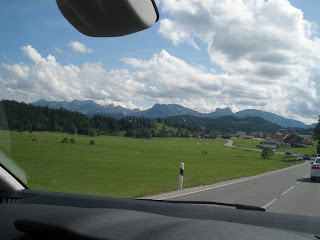
We only had one evening, night, and morning in Rothenburg ob der Tauber. This was the only place where we only stayed one night. (There are other Rothenburgs in Germany, thus the qualifier. Now that we are all clear on which Rothenburg it is, I will henceforth call it simply Rothenburg. And may I say here, keeping straight what is spelled 'burg' and what is spelled 'berg' is a pain? I think there is a reason to the difference - burg is town, berg is mountain, but is doesn't always seem that clear to me. And maybe I should apologize for misspellings in the blog - I think I am a decent speller, but something happens while writing blog posts that messes with my ability to spell, so, sorry about THAT!)
(After that aside,) Don hopes that we can return and spend more time in Rothenburg. It has it's charms, to be sure, and I am willing to give it more time, too.
Rothenburg had a whopping 6,000 people in residence in its heyday, from 1150 to 1400. Today, 2/3 of the residents are now employed serving the tourist trade. But, in the evening and morning, it was a quiet, charming town.


The town hall.
Rothenburg is Germany's best-preserved medieval walled town - according to the guidebook. And the wall is one of the big things to see here.

This is looking down a street toward one of the wall towers. On the right there, next to Don, is a fountain.

The same tower from farther back. Notice the wrought iron shop signs.

Looking at another tower down a different street.

The wall.

You can walk the entire wall. It was barely tall enough for Don to walk - he had to do a lot of stooping under roof supports.

More of the wall.

These are some of the stairs that provide access to the wall - narrow and steep.

The Rothenburg skyline from the wall.

More skyline. Don loves these German town skylines - a mess of red roof and sky.


This is a hotel.

This building is outside the walled city. Click on it to see the beautiful blue clock better - the reason for the picture :)

St. Jacob's from the wall, which gives you a good idea of how much renovation was going on on the church.

A road goes right through St. Jacob's.

St. Jacob's


The main altar.


This little organ was sitting on the floor to the side.

But this is the main organ.

And the big treat in St. Jacob's is hidden up in the organ loft: Tilman Riemenschneider's Altar of the Holy Blood. Riemenschneider is called the Michelangelo of German woodcarvers. He carved this altar from 1499 to 1504. It is 35 feet tall. Our pictures are woefully inadequate.









Back down on the main floor of the church there are two other altars, carved by students of Riemenschneider.



Other sights around Rothenburg:

The glass in this old window was green - you can only see that if you click on it. But I inadvertently got a picture of a woman watering flowers. There are flower boxes everywhere.


The restaurant where we had lunch - outside - before leaving.

I wondered about all the people who lived in town - where did they park their cars? Well, this is a garage that serves numerous residents. There are gargaes like this every so often between the other buildings.

A covered brigde outside the wall.

Rothenburg also is home to the Medieval Crime and Punishment Museum - a fascinating and morbid place. This is just one of the many tortue items on display.

The lane that our room was on. You can drive a car down here, if you are okay with about 2 inches of clearance!

The door to the home where we stayed. The windows on the right are our room.

Our room was very yellow and orange. It was okay - cheery.

The wall says something to the effect that Morning has gold in its mouth. It might be a colloquialism.

























































































